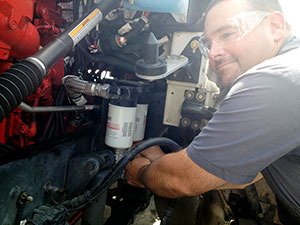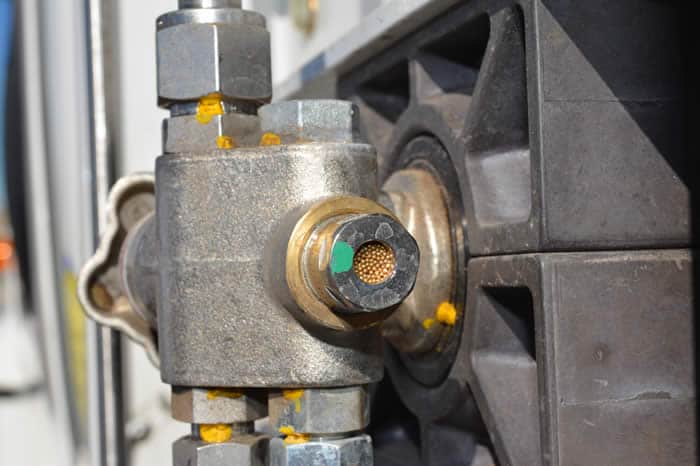By Kasia McBride, Marketing Manager, NGVi
 Every technician who works on or around CNG vehicles should be familiar with the basic safety concerns for these vehicles. While CNG has three main hazards, including high pressure, fire and asphyxiation, the primary hazard is high pressure. This is because the nominal fill pressure of compressed natural gas (CNG) stored onboard natural gas vehicles is 3,600 psi, and that pressure can be deadly if it is not treated with respect.
Every technician who works on or around CNG vehicles should be familiar with the basic safety concerns for these vehicles. While CNG has three main hazards, including high pressure, fire and asphyxiation, the primary hazard is high pressure. This is because the nominal fill pressure of compressed natural gas (CNG) stored onboard natural gas vehicles is 3,600 psi, and that pressure can be deadly if it is not treated with respect.
To address high-pressure concerns, all CNG fuel systems are equipped with many distinctive safety features. One of them is that, by manufacturing code, the high-pressure CNG fuel system components other than CNG cylinders are designed to withstand four times their rated pressure, which allows them to withstand at least 14,400 psi without bursting.
CNG cylinders also are manufactured to rigorous federal standards, and are made from much sturdier materials than gasoline or diesel fuel storage tanks. According to the standards, all CNG fuel storage cylinders must be manufactured to withstand 2.25 times their fill pressure. This means that all CNG cylinders have a minimum burst pressure of 8,100 psi which is far above the fuel delivery pressures of CNG fueling stations.
 Furthermore, to protect CNG cylinders from rupture in the event of fire or other over pressurization, pressure relief devices (PRDs) are installed which “activate” (open) at a specified temperature or pressure, and thereby relieve the CNG cylinder of its pressurized contents if the pressure becomes excessive. Each cylinder is equipped with at least one of these mandatory safety devices—and many cylinders have two or more PRDs.
Furthermore, to protect CNG cylinders from rupture in the event of fire or other over pressurization, pressure relief devices (PRDs) are installed which “activate” (open) at a specified temperature or pressure, and thereby relieve the CNG cylinder of its pressurized contents if the pressure becomes excessive. Each cylinder is equipped with at least one of these mandatory safety devices—and many cylinders have two or more PRDs.
While these features help assure safety, it is important to remember that any high-pressure fuel system or component can be dangerous if maintained using unsafe procedures. It is therefore crucial that technicians who have daily contact with the high-pressure systems are aware of the appropriate maintenance and repair practices and safety procedures to assure their safety, and to avoid possible hazards of pressure.
Below are some general rules each NGV technician must follow while servicing, maintaining and repairing NGVs.
Since manufacturer requirements cover specific types and brands of fuel system components, technicians should always refer to them as the primary source of information.
It is essential that before they start working on NGVs, technicians must be familiar with each component within the CNG fuel system. They should also be able to identify whether it is a high- or low-pressure component.
Technicians should always remember to turn off the gas supply to the specific section of the fuel system prior to working on it.
They should depressurize the area of the CNG fuel system where repairs are necessary, and if needed, they should defuel all or a portion of the fuel system using the correct defueling procedure.
Finally, as an important safety precaution, technicians should treat every fitting and component on a fuel system as if it contains high pressure. Unless they are certain the pressure has been relieved, they should never attempt to tighten, loosen or service any high-pressure fitting or component.
Special procedures must also be followed while performing service or repair of CNG cylinders, valves or PRDs. Before servicing these components, technicians should always remember to close the quarter-turn valve to shut off the flow of gas to the remainder of the high-pressure fuel system. When necessary, they should also use the defueling procedure specified by the manufacturer to completely defuel the affected cylinder(s).

Depending on whether the high-pressure CNG fuel system does or does not have a defueling port or bleed valve, there are two different types of system depressurization procedures. In the case when a defueling port or bleed valve is present, technicians should first close the cylinder valves or disconnect the cylinder electric solenoid valves prior to depressurizing, thus preventing the flow of gas from the cylinders to the remainder of the CNG fuel system. Then, they should use the defueling port or bleed valve to depressurize the remainder of the high-pressure fuel system.
For vehicles that do not have a defueling port or bleed valve, the typical depressurization procedure starts with closing the cylinder valves or disconnecting the cylinder electric solenoid valves, and then performing the rundown procedure (outlined below), which is commonly used to depressurize portions of the CNG fuel system (not including the cylinders):
- Shut off all of the individual cylinder valves or disconnect cylinder electric solenoid valves.
- Start the engine and let it run until it stalls or shuts off.
- After a short while (about two minutes), try to restart the vehicle–which should not start. To verify that the cylinder valves have sealed in the closed position and have shut off the gas flow from the cylinders, repeat the attempt of restarting the vehicle until you are sure the engine will not start.
- If the engine will not run, the high-pressure fuel system should have very low pressure—less than 150 psi.
- To confirm this, check the high-pressure fuel gauge. It is essential to verify that the system has very low pressure before you proceed. Also, remember that only the section of the fuel system downstream of the closed cylinder valves are depressurized and can be safely disassembled.
- Use two wrenches to open a fitting just to the point where gas begins to flow.
The following is a generic description of one procedure for depressurizing the low-pressure CNG fuel system components.
- Whenever possible, follow manufacturer’s procedures.
- Close all cylinder valves or disconnect the cylinder electric solenoid valve.
- Using the vehicle’s defueling port or bleed valve, depressurize the high-pressure fuel system.
- Next, use a bleed valve (if present) to complete the depressurization process. If no bleed valve is present, technicians may need to use two wrenches to disconnect the fitting of the component to be serviced. Use one wrench to hold the body of the fitting and the other wrench to turn the fitting nut. This will prevent damage to the fitting.
Fleet safety should be routine, and not reserved for special occasions. With sufficient training, including all appropriate procedures and appreciation for system pressure, NGV technicians can perform CNG fuel system maintenance safely and routinely as well. It is only with proper training, however, that this level of competency can be achieved.

